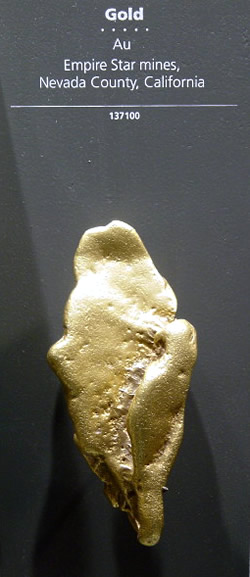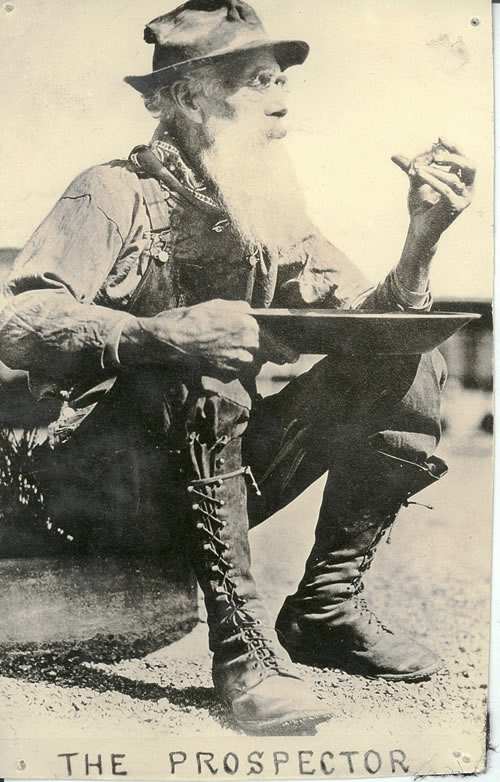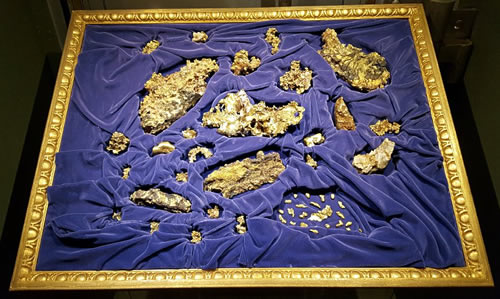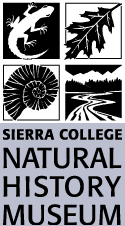Gold
Richard P. Hilton and Joe Medeiros
Sierra College

No other US state has been so profoundly influenced by its geology as California. Gold changed our entire nation when it initiated the first world-class gold rush after its discovery in 1848. It was intimately involved in the funding of the Civil War, the emancipation of African slaves, and the rapid transformation of the Spanish-Mexican west into American statehood. Designated in 1965, gold is recognized as the State Mineral.
Gold is a pure element. Its chemical symbol (Au) comes from the ancient Roman aurum meaning shining dawn or morning glow. It hovers at atomic number 79 between platinum and mercury, among the precious metals as well as other “poor metals.”
Formed During the Mesozoic
While dinosaurs were wandering the Earth during the Mesozoic Era, veins of gold were being injected as liquids into the cracks of metamorphic and granitic rocks. Such veins became exposed as the ancestral Sierra gradually uplifted during the erosive times of the Cenozoic Era. Eocene and Oligocene Sierra rivers were rich with nuggets, flakes and fragments of gold as they washed slowly downstream. There they sat among the sand and gravel (the auriferous gravels) for millions more years, awaiting their “discovery” by humans.
When gold was first found in present day channels, the easy pickin’s were among river sediments. A shovel, a pan, and pocket knife was all that was needed by “placer” miners. Soon after, they employed rockers, cradles and other simple mechanical methods that sorted lighter from heavier and larger from smaller river materials. Solitary miners often joined with others and began using more sophisticated machinery (long toms, sluices, etc.). Then the advent of mine corporations issued in. Once the easy placer gold panned out, better tools were needed to dig deeper into the river gravels and even reroute rivers to get at their beds. Environmentally devastating hydraulic mining of the ancient channels washed uncountable amounts of sediment into our rivers and streams. Massive dredges with huge bucket chains working on the lower portion of rivers could process many more cubic meters in a day. Hard rock mining of the quartz veins wrested gold from its source in the bedrock.
Gold Districts
In the Sierra Nevada, three main gold “districts” stood out. The largest, la Veta Madre or the Mother Lode, was the first to be explored and exploited. Only a few miles wide, the Mother Lode veins ran more than 120 miles long, trending NW-SE from El Dorado County in the north, through Amador, Calaveras, and Tuolumne Counties, ending in Mariposa County in the south. Most of this gold was embedded in quartz veins and other rocks of the Sierra foothills. Hard-rock mining and tunneling had begun in earnest. The second largest district was the Grass Valley-Nevada City district farther north (see Empire Mine and Malakoff Diggings). A third large district, the Columbia Basin/Jamestown/Sonora, developed in the southern Mother Lode (see Columbia State Park). Gold was also found even farther south in Mariposa. The first mill to crush ore and extract gold in California was founded here by John C. Fremont and Kit Carson (near the Mariposa Vein).
By 1996 more than 116 million troy ounces (nearly 8 million pounds) had been extracted from California. At today’s market value ($1200/oz.) this equates to approximately $139 billion.
"Discovery" of Gold

While native peoples had certainly seen it long before in the rivers, Euro-American history tells us that gold was “discovered” in 1848 by James Marshall. He noticed it in the mill race of a logging operation at Sutter’s Mill in the village of Coloma, on the South Fork of the American River. The discovery set off the California Gold Rush of 1849, bringing hundreds of thousands of gold-seekers over land and by sea from all parts of the world. Just a year later in 1850, California gained its statehood, bypassing Territory status entirely.
Natives Had No Use for Gold
My students often ask me why gold was considered so valuable. My answer is, “Because we think it is.” The original inhabitants of the Mother Lode in the western foothills of the Sierra didn’t even think it was worth collecting. It was no more worthy than the shiny flakes of mica they found in local rocks and along waterways. In fact, native peoples collected mica and used it for ornamentation while gold was ignored. To them, abalone shells were much prettier than gold, and obsidian much more useful.
Certainly, gold has numerous industrial uses but its main value comes from our curious (and often obsessive) desire to possess it. Unlike most other metals gold does not tarnish or rust. Silver tarnishes black and iron flakes away in reddish scabs, while gold retains its bright, yellow luster forever.
Peoples of the Old World cherished gold for thousands of years and native peoples of Central and South America treasured it as well. Euro-Americans arrived thousands of years after gold’s first human discoverers. When gold-seekers came to California, landscapes were denuded of their protective vegetation, rivers were rerouted and their beds virtually turned upside-down. The waters were polluted and their fish killed—all for few ounces of this curious yellow metal.
Destruction!
Giant pits were dug and holes blasted deep in the earth. Horses, mules and oxen were enslaved, some living their entire lives deep underground to haul the ore and move the rock. Mercury, one of the world’s most toxic materials, was used to separate this yellow metal from the rock. Rivers and streams were dammed and their contents diverted into ditches and pipes. The weight of the impounded water would gush forth from giant monitors, all to erode the land away to reveal the precious golden flakes.
Historically, indigenous peoples have been cast aside, enslaved or often murdered just for “sport.” Exacerbated by the Gold Rush the population of native Sierrans plummeted. The decimation began at the hands of the Californios, later the Mexicans, and finally the Euro-Americans. Thousands of years of rich California human history was virtually erased by enslavement, disease and environmental annihilation. Mary Hill (Gold, the California Story) proclaimed that, “Bigotry set its mark on California and has yet to be totally erased.”
Gold is Still Being Discovered
Today the Gold Rush continues, albeit in very different venues and methodologies. Not so much in California, but massive open pits are being excavated around the world in places like Nevada and the Yukon. In Nevada, mountains and landscapes are being leveled. The 8th and 9th largest mines in the world are along the Carlin Trend in Nevada, southwest of Elko. Fly over the Carlin area of northeastern Nevada if you can, or just locate the region using Google Earth. Carlin and nearby Cortez are areas that are “out of sight” and largely out of mind. This beautiful intermountain region is presently being converted to an open-pit wasteland.
Regardless of the size of these mega-mines, China is the largest gold producer in the world at this time, followed by Australia and then the United States (NV [75%], AK, CA, SD, CO). While the largest gold mines and projected reserves are in South Africa, the largest existing “single” mines are in Indonesia, western Australia and Papua New Guinea.
Alaska’s highly controversial Pebble Mine has been ranked second to Indonesia’s Grasberg Mine in terms of potential. Near the spectacular Lakes Iliamna and Clark, the Pebble Mine project (on hold since 2013) is also within the headwaters of the rivers and streams that flow into Alaska’s world-renowned Bristol Bay salmon fisheries. Might these “new Gold Rushes” be as socially and environmentally damaging as that of our own California history?
The Golden State and the Mother Lode
These terms sound warm and fuzzy and evoke good feelings in most, but there was and still is a terrible price to pay for such selfish and egregious actions. Even today our waters have significant traces of lingering mercury, enough that we are restricted in the amount of fish we can safely eat from our lakes, rivers and streams. Many of our river channels are still clogged with sediment from the extensive hydraulic mining activities of more than 150 years ago.
State agencies work year-round on identification of toxic sites and cleanup efforts. California’s Department of Conservation has a great deal of helpful information about what has been called “mining’s toxic legacy.”
NGOs (non-government organizations) like The Sierra Fund focus on toxicity of mines and waterways that are remnants of the Gold Rush era.
https://www.sierrafund.org/focuses/mercury-in-the-sierra/
Ongoing Monitoring
Other organizations, like the Sierra Streams Institute, work hard to monitor and remediate Sierra waterways that have been negatively affected by mining activities of long ago. They involve citizen volunteers, especially young people, in their aquatic ecosystem monitoring and restoration projects. http://www.sierrastreamsinstitute.org
Fortunately, nature is resilient. Thanks to its ability to recycle and detoxify, given enough time and space, some of the badlands topography of our former hydraulic mines are becoming almost beautiful as they heal. The Malakoff Diggings is a striking and marvelously instructive place to visit. There, the once-denuded landscapes are now naturally reforested and many of the old mines are thought-provoking and interesting historic places to visit.
So, what are the results of California’s grand Gold Rush?
Mary Hill (1999) summarized her Gold Story:
To the miner, gold is a livelihood; to the prospector a vision; to the investor, a profit; to the goldsmith, a metal of promise and a thing of beauty. To the alchemist, it was a route to everlasting life. To the newlywed, it is a symbol of eternity; to the dispossessed, security; to the homeless, asylum.
Yet gold itself is none of these. It is merely a metal, like tin, or lead, or iron. Gold, though it may be a maker of kings and a seducer of saints, is neither friend nor enemy. It is the reflector of our dreams.
Go See It!

Good, bad or indifferent, California’s Gold Rush is part of our very famous/infamous history. Thanks to native peoples, other story-tellers, collectors, photographers, artists, and historians, this history is available to us.
Initially, California’s gold was taken from its rivers. To experience the physical environment of the gold-rich placers, one can travel to the Auburn State Recreation Area and hike the trails along and above the North and Middle Forks of the American River. A little farther north, one can visit the South Yuba River State Park for a similar experience. At Marshall Gold Discovery State Park in Coloma, you can walk among the rocks near the very place on the South Fork of the American River where California’s Gold Rush essentially began.
The Empire Mine State Park in Grass Valley is an example of one of the largest mines in the northern Sierra Nevada. Here, the largest, deepest and most productive mine in the northern Sierra is available, at least above the surface, for viewing and its story told.
Hydraulic Mining
There is little doubt that the most destructive form of gold mining was hydraulic. Hillsides and entire mountainsides were literally washed downstream using high-pressure hoses and nozzles (monitors). The most dramatic results of this mining technique can be seen at Malakoff Diggings State Park north of Nevada City. You can also see some of its effects at Gold Run Rest Stop on interstate 80.
Elegantly romanticized, Columbia State Park near Sonora preserves the Gold Rush theme with beautifully restored streets, homes, hotels and saloons.
Farther south, in Mariposa, the California State Mining and Mineral Museum houses an extensive collection of specimens and artifacts of the Gold Rush. In addition, the museum exhibits the largest remaining “mass” of crystalline gold that remains in California. Since most gold was melted down, few large specimens remain. One such specimen, the Fricot Nugget, weighs 13.8 pounds!
Then, if you haven’t had enough California gold history yet, don’t miss Bodie State Historic Park off Hwy 395, south of Bridgeport and north of Lee Vining. Just east of the Sierra Nevada (near Yosemite National Park), the remarkable ghost town has been maintained in “arrested decay.”
Sierra College Press eJournals
The Journal of Sierra Nevada History and Biography issue (Spring 2009 V2 N1)
is devoted to California Gold Rush history. Articles, videos, audio clips, art and photographs abound in this issue. Find it at: GOLD RUSH STORIES
Sierra College Press has been co-publishing books with Bay Area publisher Heyday since 2010 when it produced The Illuminated Landscape: A Sierra Nevada Anthology.
One of the co-editors of that anthology, Gary Noy, has written two books focusing on historic characters and events of the Sierra Nevada. Earlier this year (2017), we published Gary’s Gold Rush Stories: 49 Tales of Seekers, Scoundrels, Loss and Luck.
Gary’s masterpiece was introduced by Gary Kurutz, a Gold Rush specialist and past Director of Special Collections at the California State Library. This wonderful collection of expertly-researched true stories are told with intimacy and honesty. If you want to know what it was like to live during the Gold Rush in California—the good, the bad and the ugly—then this is the book for you!
https://heydaybooks.com/book/gold-rush-stories/
Resources
- California Department of Conservation
- California Department of Conservation/historic gold mines in CA
- Hill, Mary. 1999. Gold: The California Story. (Berkeley, UC Press. 306 pp.)
- Placer County Museums photos
State Parks of the Gold Rush Kind
- Auburn State Recreation Area
https://www.parks.ca.gov/?page_id=502 - Bodie State Historic Park
https://www.parks.ca.gov/?page_id=509 - California State Mining and Mineral Museum
https://www.parks.ca.gov/?page_id=588 - Columbia Historic State Park
https://www.parks.ca.gov/?page_id=552 - Empire Mine State Historic Park
https://www.parks.ca.gov/?page_id=499 - Malakoff Diggings State Historic Park
https://www.parks.ca.gov/?page_id=494 - Marshall Gold Discovery State Park
https://www.parks.ca.gov/?page_id=484 - South Yuba River State Park
https://www.parks.ca.gov/?page_id=496
